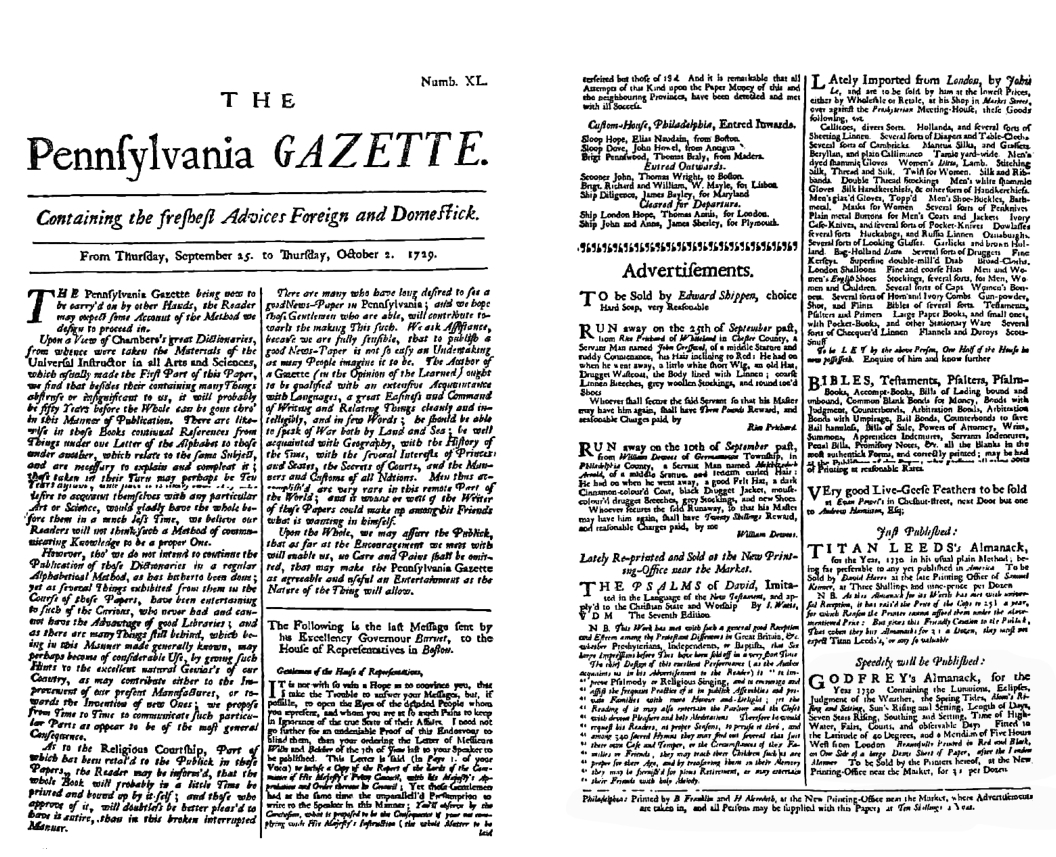




The account of how Franklin's Autobiography came to be written and of the adventures of the original manuscript forms in itself an interesting story. The Autobiography is Franklin ’ s longest work, and yet it is only a fragment. The first part, written as a letter to his son, William Franklin, was not intended for publication; and the composition is more informal and the narrative more personal than in the second part, from 1730 on, which was written with a view to publication. The entire manuscript shows little evidence of revision. In fact, the expression is so homely and natural that his grandson, William Temple Franklin, in editing the work changed some of the phrases because he thought them inelegant and vulgar. Franklin began the story of his life while on a visit to his friend, Bishop Shipley, at Twyford, in Hampshire, southern England, in 1771. He took the manuscript, completed to 1731, with him when he returned to Philadelphia in 1775. It was left there with his other papers when he went to France in the following year, and disappeared during the confusion incident to the Revolution. Twenty-three pages of closely written manuscript fell into the hands of Abel James, an old friend, who sent a copy to Franklin at Passy, near Paris, urging him to complete the story. Franklin took up the work at Passy in 1784 and carried the narrative forward a few months. He changed the plan to meet his new purpose of writing to benefit the young reader. His work was soon interrupted and was not resumed until 1788, when he was at home in Philadelphia. He was now old, infirm, and suffering, and was still engaged in public service. Under these discouraging conditions the work progressed slowly. It finally stopped when the narrative reached the year 1757. Copies of the manuscript were sent to friends of Franklin in England and France, among others to Monsieur Le Veillard at Paris.
The first edition of the Autobiography was published in French at Paris in 1791. It was clumsily and carelessly translated, and was imperfect and unfinished. Where the translator got the manuscript is not known. Le Veillard disclaimed any knowledge of the publication. From this faulty French edition many others were printed, some in Germany, two in England, and another in France, so great was the demand for the work.
In the meantime the original manuscript of the Autobiography had started on a varied and adventurous career. It was left by Franklin with his other works to his grandson, William Temple Franklin, whom Franklin designated as his literary executor. When Temple Franklin came to publish his grandfather ’ s works in 1817, he sent the original manuscript of the Autobiography to the daughter of Le Veillard in exchange for her father ’ s copy, probably thinking the clearer transcript would make better printer ’ s copy. The original manuscript thus found its way to the Le Veillard family and connections, where it remained until sold in 1867 to Mr. John Bigelow, United States Minister to France. By him it was later sold to Mr. E. Dwight Church of New York, and passed with the rest of Mr. Church ’ s library into the possession of Mr. Henry E. Huntington. The original manuscript of Franklin ’ s Autobiography now rests in the vault in Mr. Huntington ’ s residence at Fifth Avenue and Fiftyseventh Street, New York City.
When Mr. Bigelow came to examine his purchase, he was astonished to find that what people had been reading for years as the authentic Life of Benjamin Franklin by Himself, was only a garbled and incomplete version of the real Autobiography. Temple Franklin had taken unwarranted liberties with the original. Mr. Bigelow says he found more than twelve hundred changes in the text. In 1868, therefore, Mr. Bigelow published the standard edition of Franklin ’ s Autobiography. It corrected errors in the previous editions and was the first English edition to contain the short fourth part, comprising the last few pages of the manuscript, written during the last year of Franklin ’ s life. Mr. Bigelow republished the Autobiography, with additional interesting matter, in three volumes in 1875, in 1905, and in 1910. The text in this volume is that of Mr. Bigelow ’ s editions. [2]
The Autobiography has been reprinted in the United States many scores of times and translated into all the languages of Europe. It has never lost its popularity and is still in constant demand at circulating libraries. The reason for this popularity is not far to seek. For in this work Franklin told in a remarkable manner the story of a remarkable life. He displayed hard common sense and a practical knowledge of the art of living. He selected and arranged his material, perhaps unconsciously, with the unerring instinct of the journalist for the best effects. His success is not a little due to his plain, clear, vigorous English. He used short sentences and words, homely expressions, apt illustrations, and pointed allusions. Franklin had a most interesting, varied, and unusual life. He was one of the greatest conversationalists of his time.
His book is the record of that unusual life told in Franklin ’ s own unexcelled conversational style. It is said that the best parts of Boswell ’ s famous biography of Samuel Johnson are those parts where Boswell permits Johnson to tell his own story. In the Autobiography a no less remarkable man and talker than Samuel Johnson is telling his own story throughout.
F. W. P.
The Gilman Country School,
Baltimore, September, 1916.
NOTES:
[1] The Many-Sided Franklin. Paul L. Ford.
[2] For the division into chapters and the chapter titles, however, the present editor is responsible.

Pages 1 and 4 of The Pennsylvania
